I have been through the experience of retail investors in the cryptocurrency market for 17 years. In the first three years of entering the market, I invested 900,000 and was left with 150,000. All my close friends advised me to give up, thinking that my trading method was the most foolish, that I was neglecting my family and lacked ambition, and so on!
I've been insulted in every possible way! At that time, I really almost gave up and lost confidence in myself! But I was unwilling to accept that, I swore to my wife that I would give myself one last chance with the remaining 120,000! Then I continued to dive deep and explore, and later, with the remaining 1.8 million principal, I earned over 8.6 million in five years! No exaggeration! Once you truly summarize a method that belongs to you, if you want to treat trading as a second career to support your family, and strictly follow that method, you can definitely turn things around!
1. Pay attention to trading volume and anomalies.
In the cryptocurrency market, trading volume is an important indicator reflecting market activity and capital flow. If a cryptocurrency has a trading volume exceeding 50% of its average daily volume for three consecutive days, this usually indicates that a significant amount of capital has begun to pay attention to that currency. For example, when a previously relatively quiet digital currency suddenly experiences a sharp increase in trading volume, it is like a previously unpopular item in the market suddenly being snatched up by many people, which is very likely to indicate that the price of that currency is about to experience significant volatility, with a high probability of rising. For instance, when the decentralized exchange Jupiter (JUP) and NFT platform Tensor in the Solana (SOL) ecosystem saw a massive increase in traffic, pushing on-chain DEX daily trading volume to $4.8 billion and surpassing Ethereum, the price of SOL also broke through $155, and the long-short ratio in the derivatives market soared to 1.8:1. The surge in trading volume during this period was closely related to the price rise.
2. Lock in the sector leaders.
Just like paying attention to the industry growth rankings in the stock market, in the cryptocurrency market, you need to pay attention daily to the growth situation of cryptocurrency sectors. Focus on the top three sectors with the highest growth, and then select the digital currencies with the fastest growth and largest trading volumes from these strong sectors. These currencies are often the leaders in the sector, wielding strong market influence. Just like the top student in class, they are likely to maintain their lead in subsequent studies. For example, as the Ethereum ecosystem continues to develop and smart contracts and other applications become widely adopted, Ethereum (ETH), as the core currency of this ecosystem, has always held a leading position. Its price trends and market influence are crucial for other currencies within the entire Ethereum ecosystem.
3. Keep a close watch on price breakthroughs.
When the price of a cryptocurrency reaches a new high within a month and can maintain stability at that high for three days without a significant pullback, this is a strong bullish signal. This is similar to an athlete who breaks a record and can continue to perform excellently, proving their real strength. For example, after ONDO broke through the months-long descending triangle, the daily closing price steadily stood above the key resistance level, turning previous resistance into support. Technical analysts predict that its price is likely to rise further to a higher target. This stable performance after a price breakout has attracted the attention of many investors.
4. Assess the ability to resist the market.
The fluctuations in the overall cryptocurrency market have a significant impact on individual digital currencies, but strong cryptocurrencies often show strong resistance during market declines, maintaining a sideways trend. When the market rebounds, they can also rise faster than the overall index. This is like rowing upstream, requiring stronger support, showing that the currency has strong capital or fundamental support behind it. For example, during a phase of overall market adjustment, Bitcoin (BTC) may experience some decline, but certain digital currencies with unique technologies or application scenarios, like some tokens focused on decentralized finance (DeFi), can maintain stable prices and quickly start an upward trend when the market warms up, with increases far exceeding the average level of the market.
5. Observe the arrangement of moving averages.
In technical analysis, the moving average system is an important reference indicator. For cryptocurrencies, when the 5-day moving average is above the 10-day moving average, and the 10-day moving average is above the 20-day moving average, with these three moving averages diverging upwards, it indicates that the currency is in a good upward trend. This arrangement is like a staircase, providing solid support for price increases. Taking Ethereum as an example, during its price rising phase, the moving average system often shows this bullish arrangement, providing clear trend guidance for investors.
6. Catch the policy wind.
Although the cryptocurrency market is relatively decentralized, policies and macro environments still have significant impacts on it. Closely follow news broadcasts, important documents released by various governments, etc. If certain blockchain-related industries or concepts are mentioned, such as emerging blockchain application fields or significant adjustments in digital asset regulatory policies, the first digital currency projects to launch can often leverage these policy tailwinds to maintain strong performance. For example, when some countries continually introduce support policies for the electric vehicle industry, related blockchain projects, such as digital currency projects for electric vehicle supply chain management, may be the first to be favored by the market, with strong price increases.
7. Insight into institutional movements.
The influence of institutional investors in the cryptocurrency market cannot be underestimated. By looking at the leaderboard of cryptocurrency trading platforms, if you find that well-known institutional positions are buying a certain digital currency in large quantities, or if northbound funds (analogous to significant foreign capital flows in the cryptocurrency market) show continuous net inflows for three consecutive days, this usually means that these professional investment teams have conducted in-depth research and analysis and are optimistic about the future development of that currency. For example, when some large cryptocurrency investment funds start to increase their holdings in a certain project's tokens, it often triggers a market following buy-in, pushing the price of that currency up. For instance, Binance Coin (BNB) saw its price steadily rise due to continuous buying by institutional investors like Binance Labs during its development.
The key point is coming! Next, I will share with you the use of candlestick moving averages. We all know the importance of candlesticks in the stock market.
In the cryptocurrency market, these candlestick theories are only applicable to part of the market. Not all indicator analyses are useful in the cryptocurrency space. Although the accuracy of candlestick techniques is not 100%, and many candlestick concepts may seem of little use after learning, in fact, according to the experience of many experts, candlestick techniques still play a key role in the long-term analysis of cryptocurrency price trends. Regardless of which direction the price is heading, it will reflect in trading. We can use these techniques to understand the direction of price movements. Candlestick charts emphasize probabilities and guide you to a brighter path when you are confused.
Without further ado, let's get to the point.
Today we mainly focus on basic indicator strategies.
1. Moving average usage and settings.
2. RSI indicator + usage 3 value investment.
1. How to use moving averages to judge trends.
1. First, let's learn how to set the indicators.
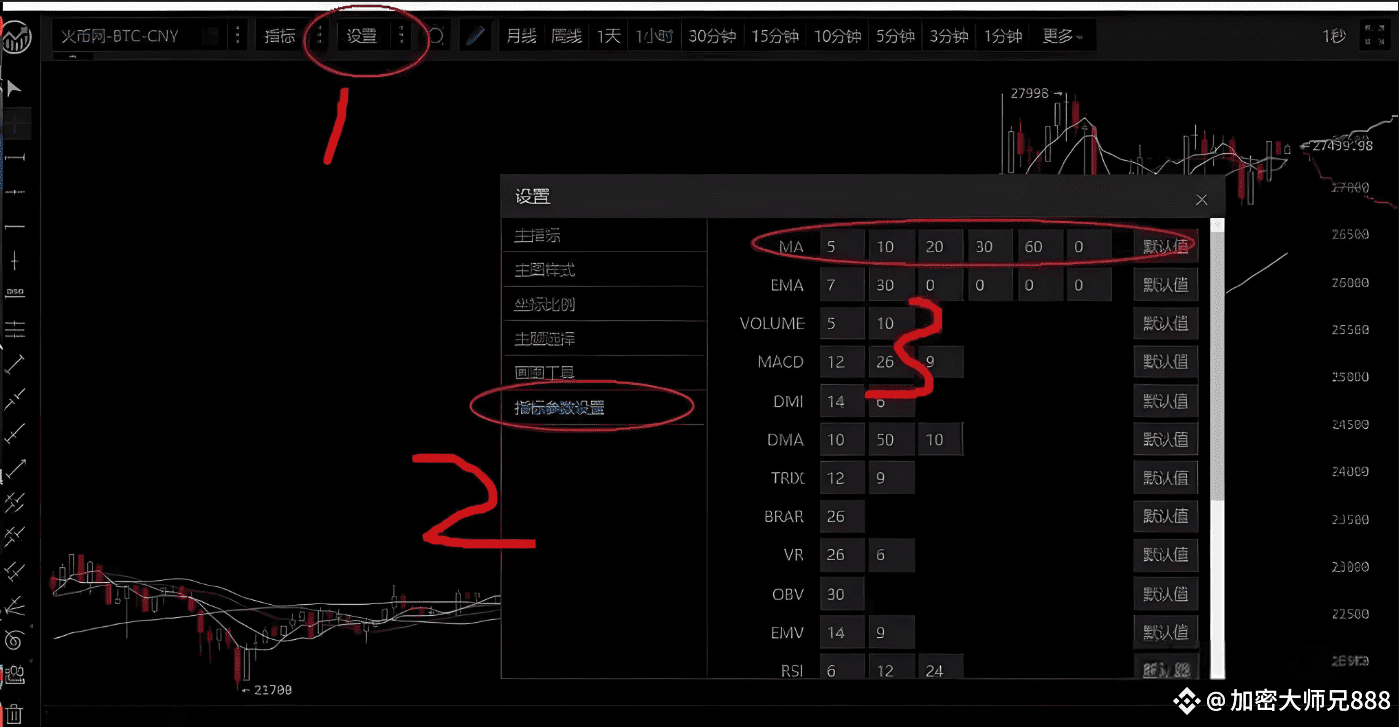
Due to some updates in the settings of Huobi, if friends cannot find it, you can directly click the line with the mouse.
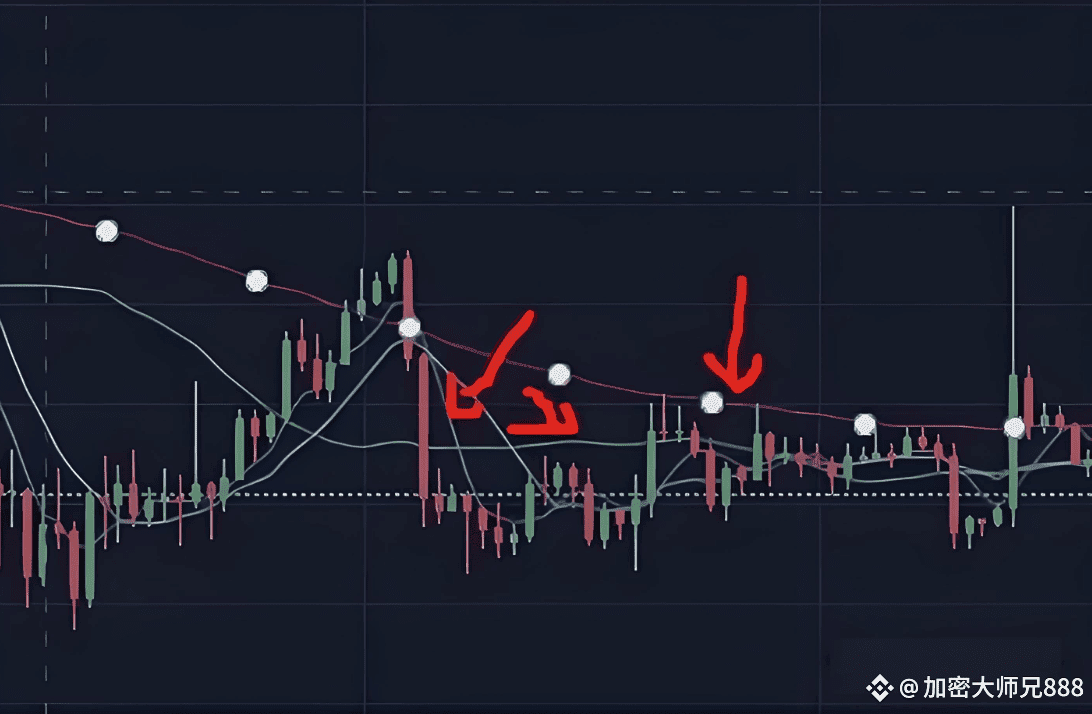
You can see these lines and directly click to modify them.
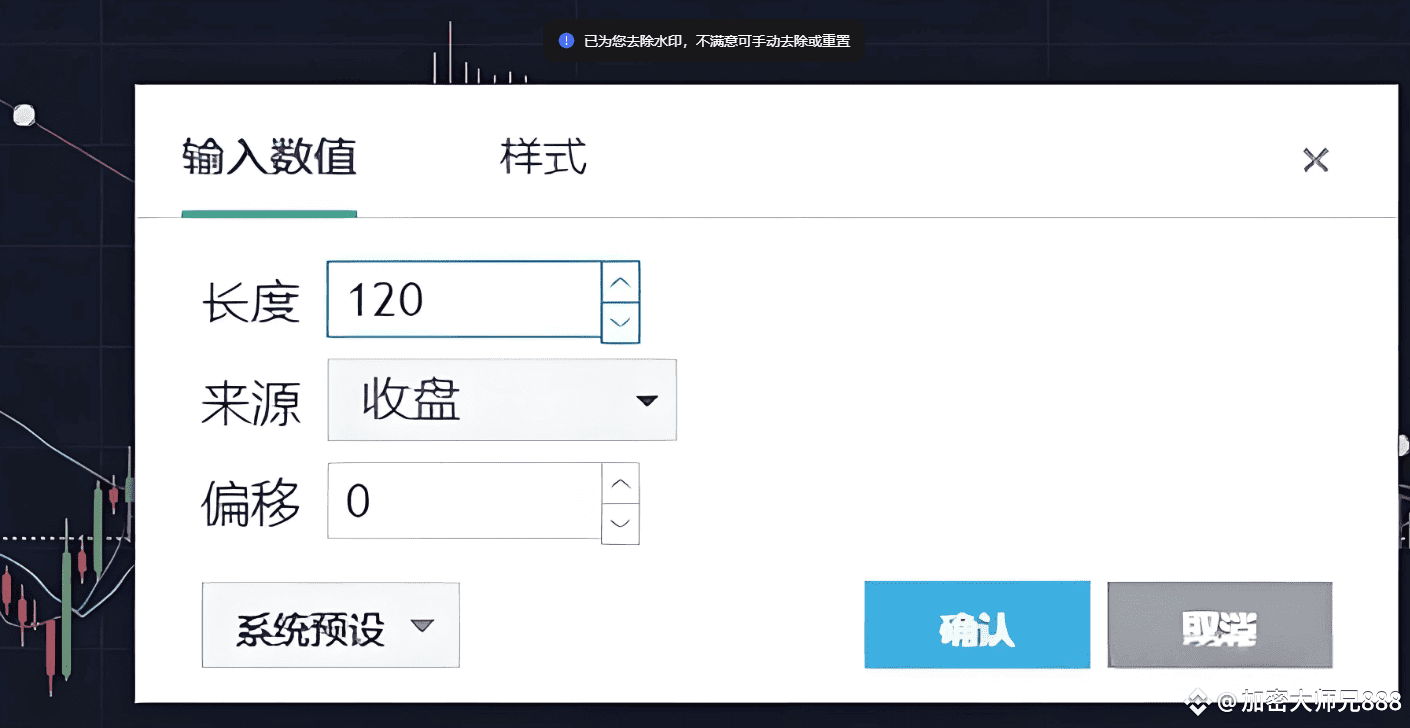
After opening, you can change it directly here. The moving averages we will use are: 5-day moving average, 30-day moving average, 60-day moving average, 120-day moving average, such as
If you feel it is not useful, you can even change the 5-day moving average to a 4-day moving average, as the market reacts more quickly.
2. Short-term moving average indicators: 5-day moving average strategy.
The 5-day moving average is commonly used for short-term trading. What is the 5-day moving average? It is the sum of the closing prices over the past five days divided by five. Generally, the system is set up to be
Weekly moving averages, to put it simply, are also based on the average price over a week, but a week's time is too long and reflects relatively slowly, of course, there are also
The four-day line used by experts, etc., can all be intuitively displayed through settings. The 5-day moving average is the most practical for short-term judgment.
The 5-day moving average represents the holding price level of everyone within five days, reflecting the buying and selling signals within five days, which is the acceptable range for everyone.
The average holding cost is the average cost, so switching the moving average is the same principle.
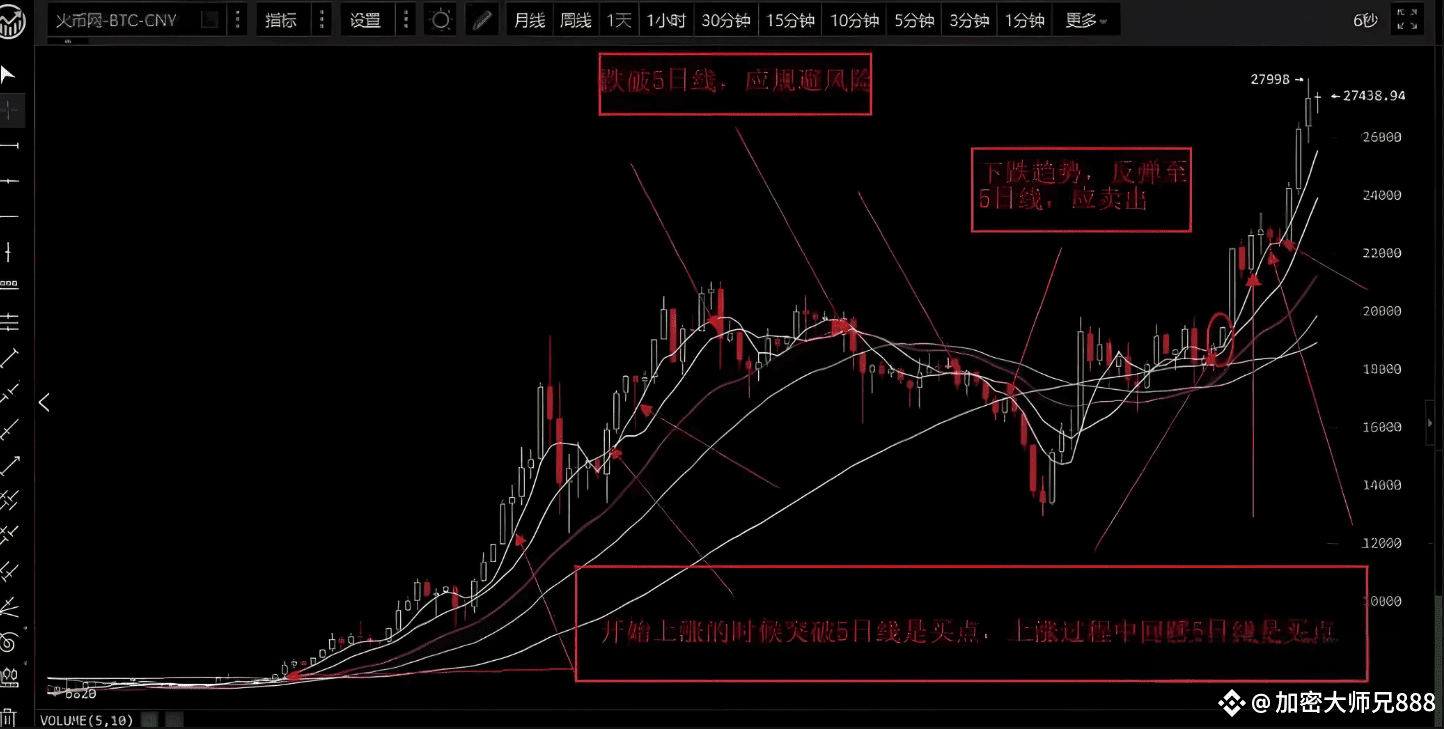
Usage: In a bull market, when the price retraces to the 5-day moving average, it is time to increase positions (if it quickly breaks below, it should be watched); in a bear market
When the price drops below the 5-day moving average, you should sell quickly. As long as it does not break below the 5-day moving average, there are generally no major issues. During a consolidation period, you can look at the 1-hour chart.
and the 4-hour chart, which is the short-term usage.
This theory requires more exploration by everyone because very few people will tell you that you will encounter many problems in practice, which requires you to explore more.
Verification: Undoubtedly, the 5-day moving average strategy is extremely useful in practice and is one of the indicators that short-term experts must rely on.
Why use the 5-day moving average? There is a saying that one day in the cryptocurrency market is equivalent to one year in the human world, and the market reacts particularly quickly. If using the conventional 7-day moving average, it would be
is relatively slow and cannot keep up with market changes. We all know that the fluctuations in the cryptocurrency market are unrestricted, and they can even occur twenty-four hours a day.
In trading.
If the 5-day moving average is used as the judgment standard, then when the price reaches the 5-day moving average, it will form a support level. If it sells, it will break below the 5-day moving average.
Once it returns to the cost price, you can only wait, and this point forms a support level.
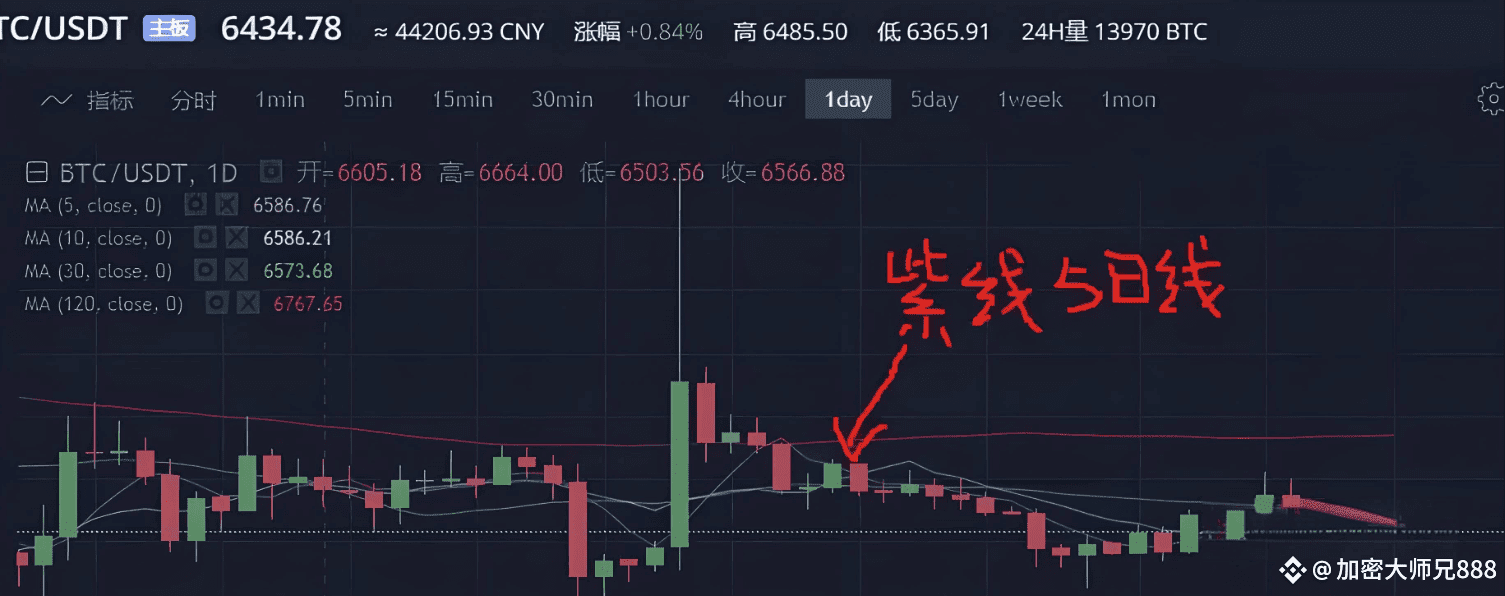
It shows that the current price still hasn't risen above the 5-day moving average, and there are still many uncertainties. At this time, we should use the hourly and four-hour charts.
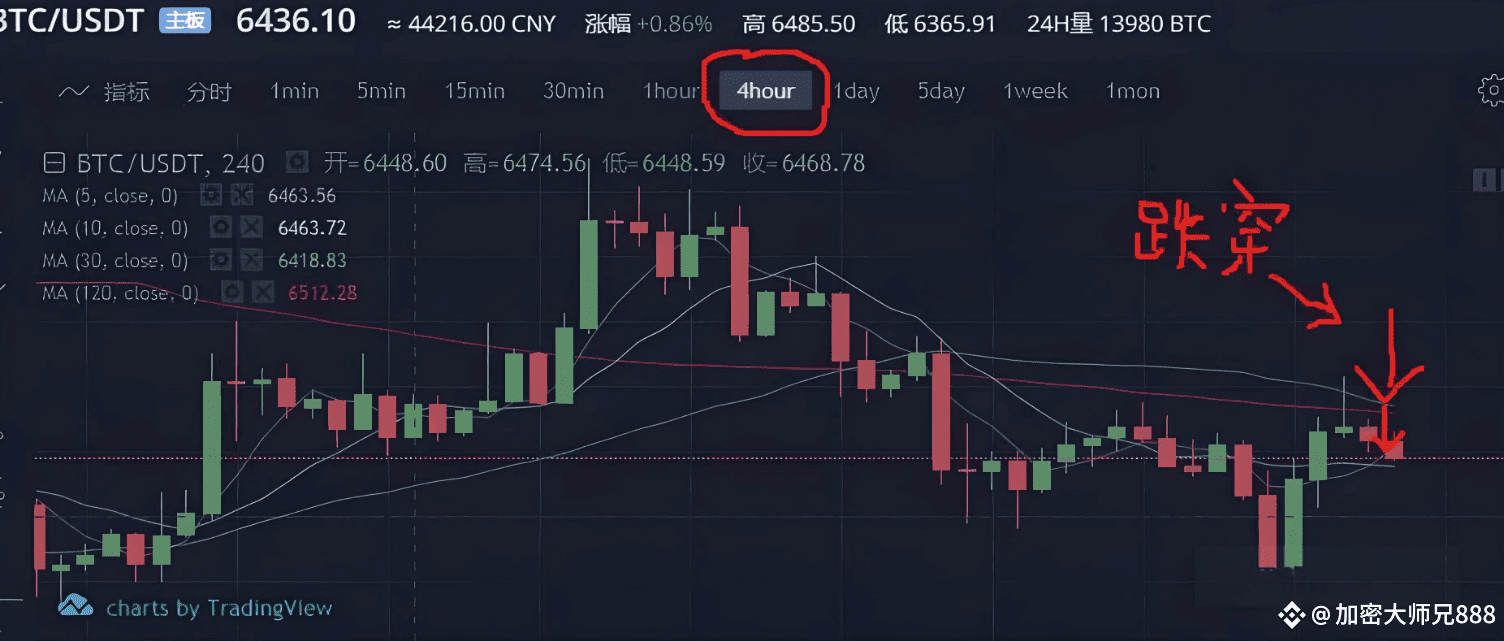
Practical summary: This trading method mainly focuses on short-term indicators. When the price approaches the moving average, which is also the cost price for most people, the selling pressure will decrease, making it relatively
The price will rise again if it deviates from the moving average too much, and the probability of adjustment will increase mainly because investors will choose to arbitrage, leading to
price decline.
3. Combining the 30-day and 10-day moving averages with short-term trading strategies.
The 30-day moving average is also a short to medium-term strategy. If you are not that fond of trading, we recommend this set of strategies to you.
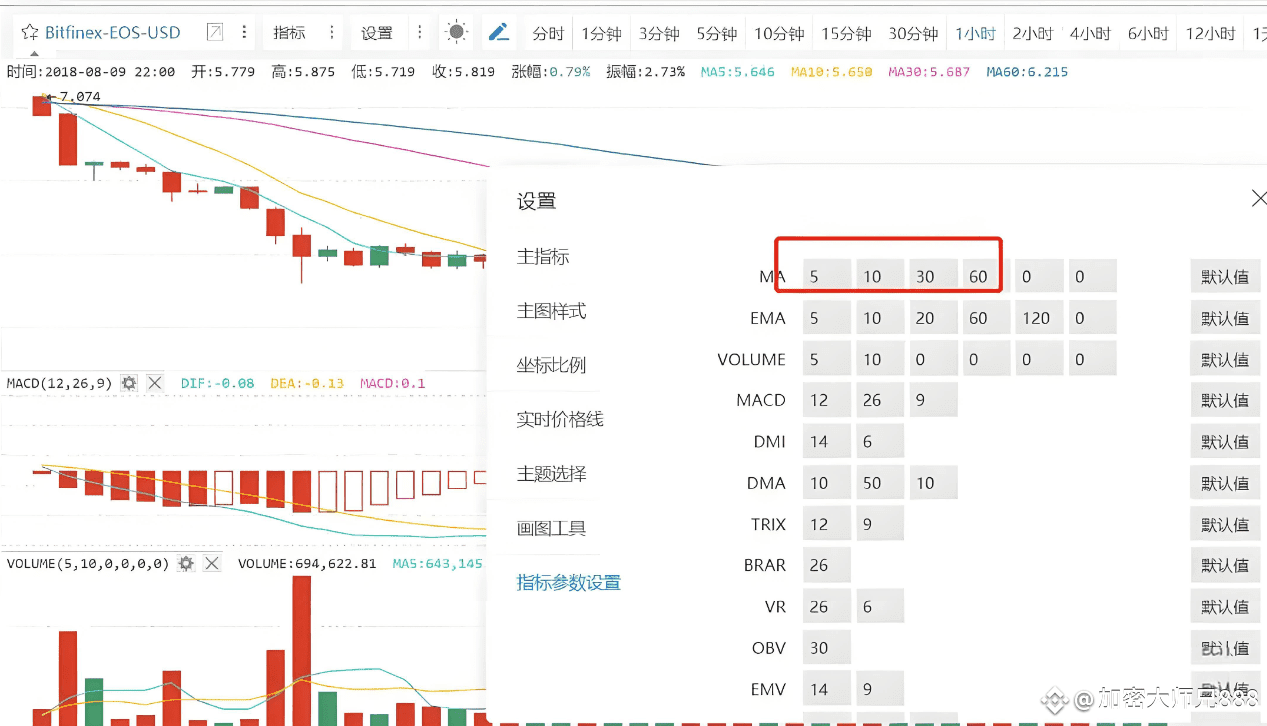
As usual, if you previously followed my settings: 5-day moving average, 30-day moving average, 60-day moving average, and 120-day moving average, just change the 60-day moving average to a 10-day moving average.
Because this set of indicators only needs to use the 10-day and 30-day moving averages.
This set of indicators is relatively simple to use: sell when breaking below the 10-day moving average, buy when breaking above the 30-day moving average. Change the time to one hour, as detailed in the chart:
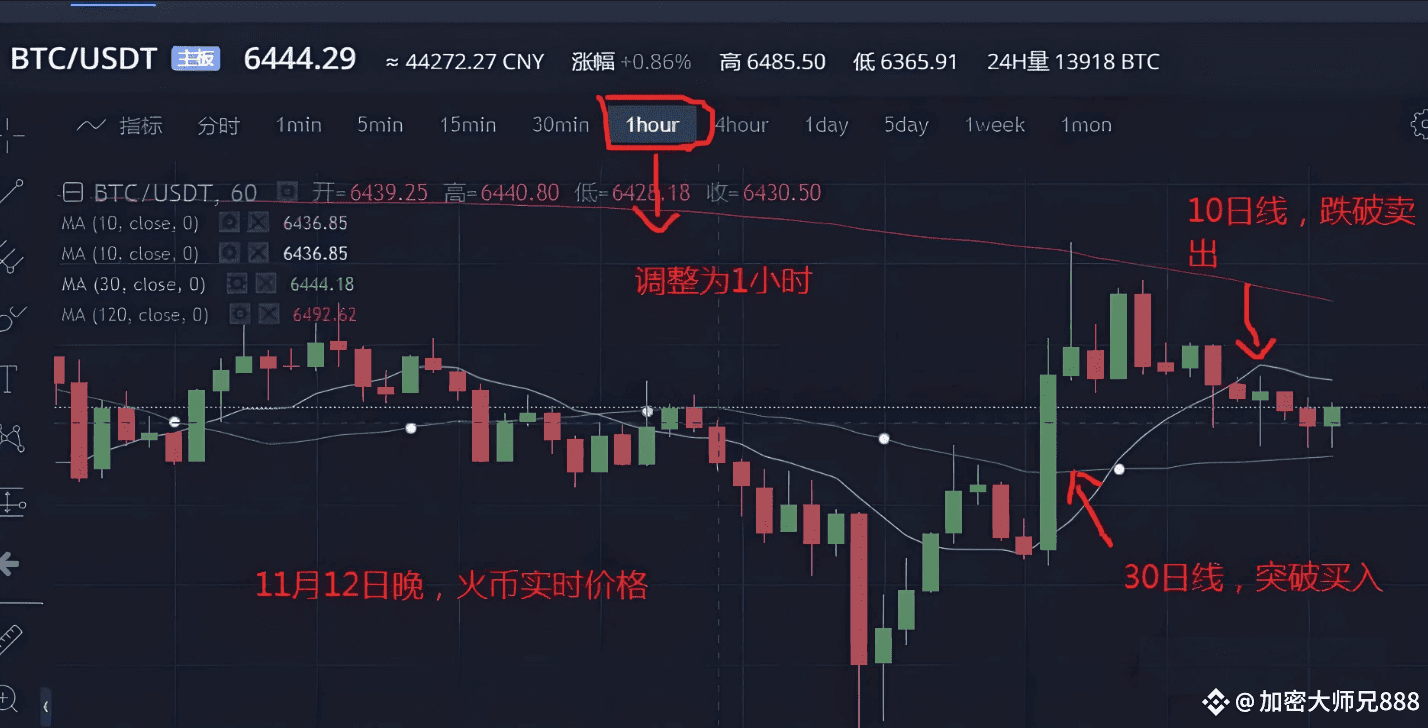
This theory is similar to the 5-day moving average; the 30-day moving average represents the short to medium-term trend. If set to one hour, it becomes a short-term buying signal, while falling
Breaking the 10-day moving average opens a short-term downward channel. Through this combination and in practical combat, it is very effective.
4. Medium to long-term trading strategy: 60-day and 120-day moving averages.
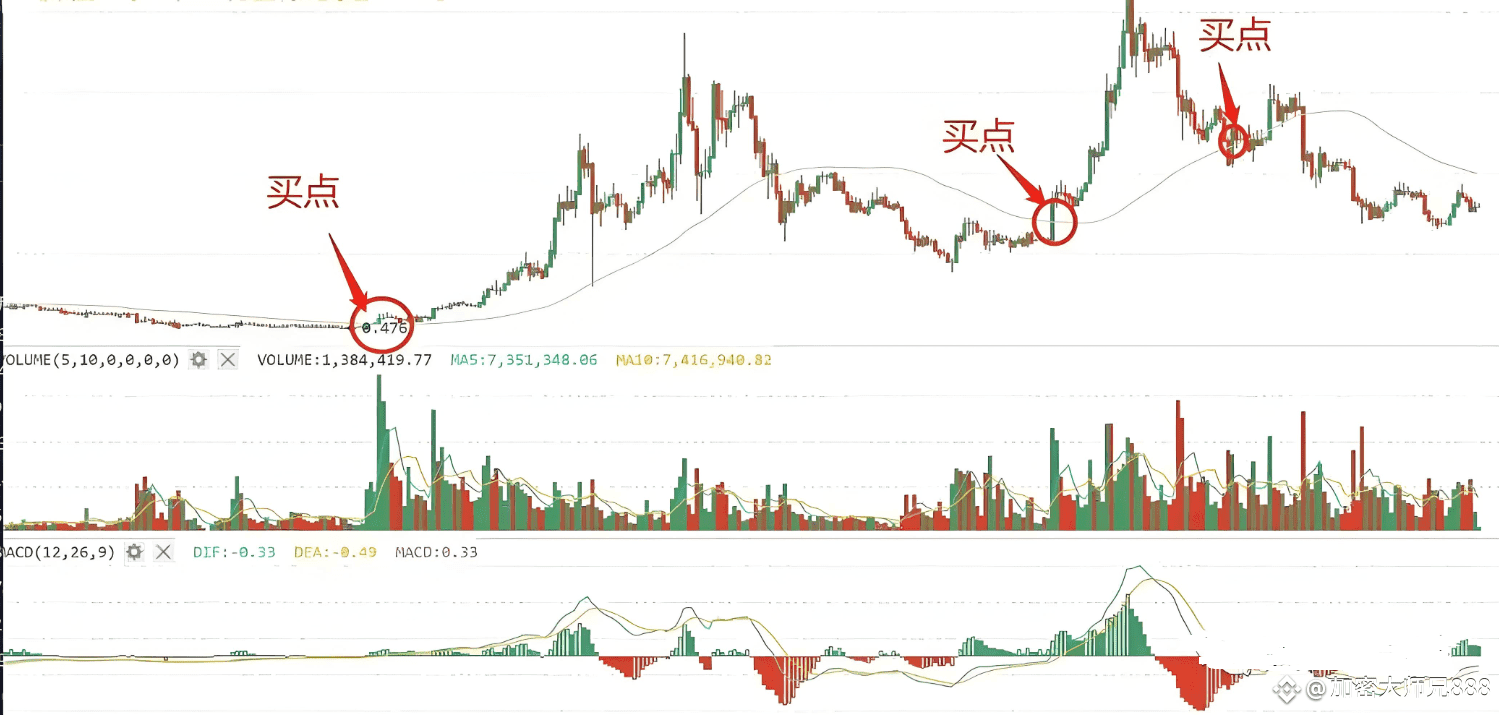
This chart shows the trend of EOS. It is said that some investors trade the bottom several times a year using the 60-day moving average for steady investment. This method is suitable for investors who do not have time to operate.
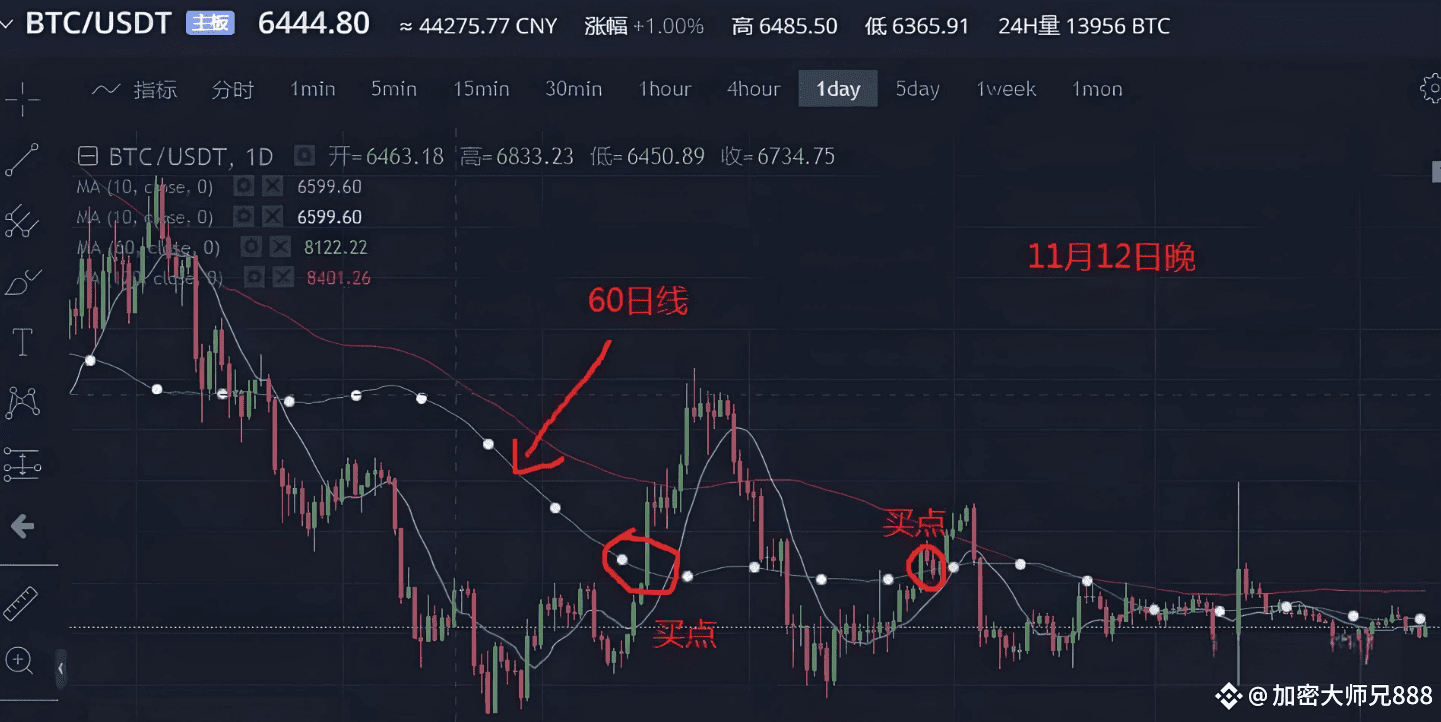
And speaking of the 120-day moving average, it is the dividing line between bull and bear.
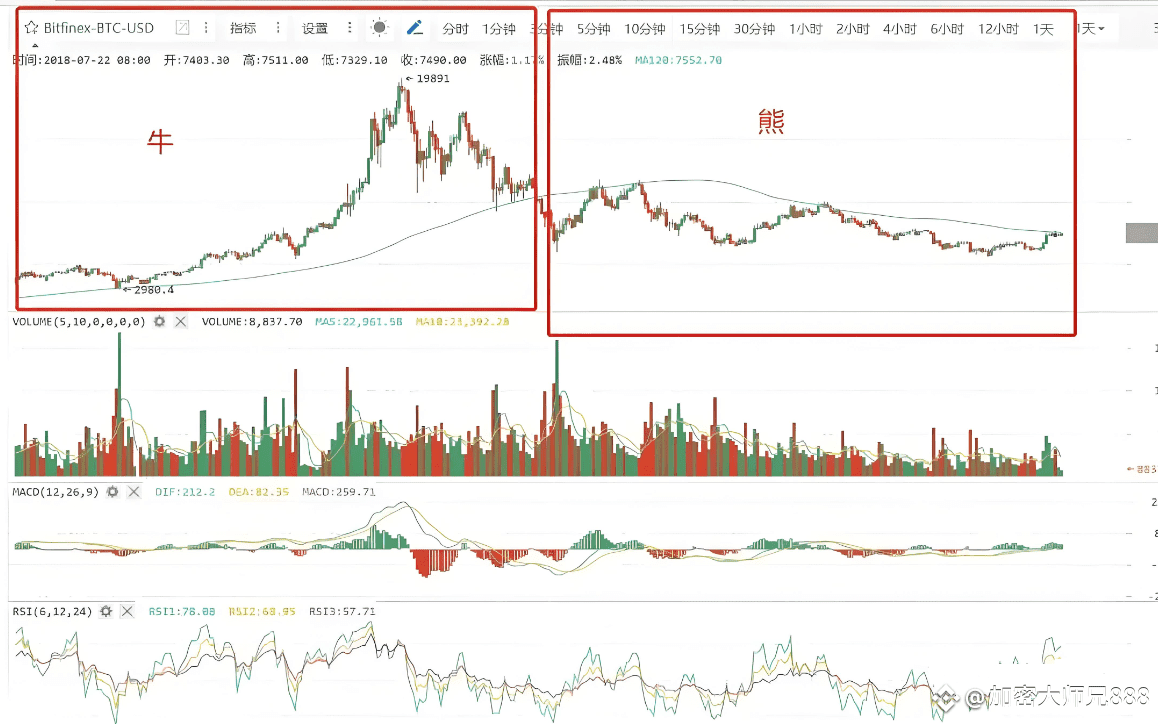
So how to use the 120-day moving average for investment?
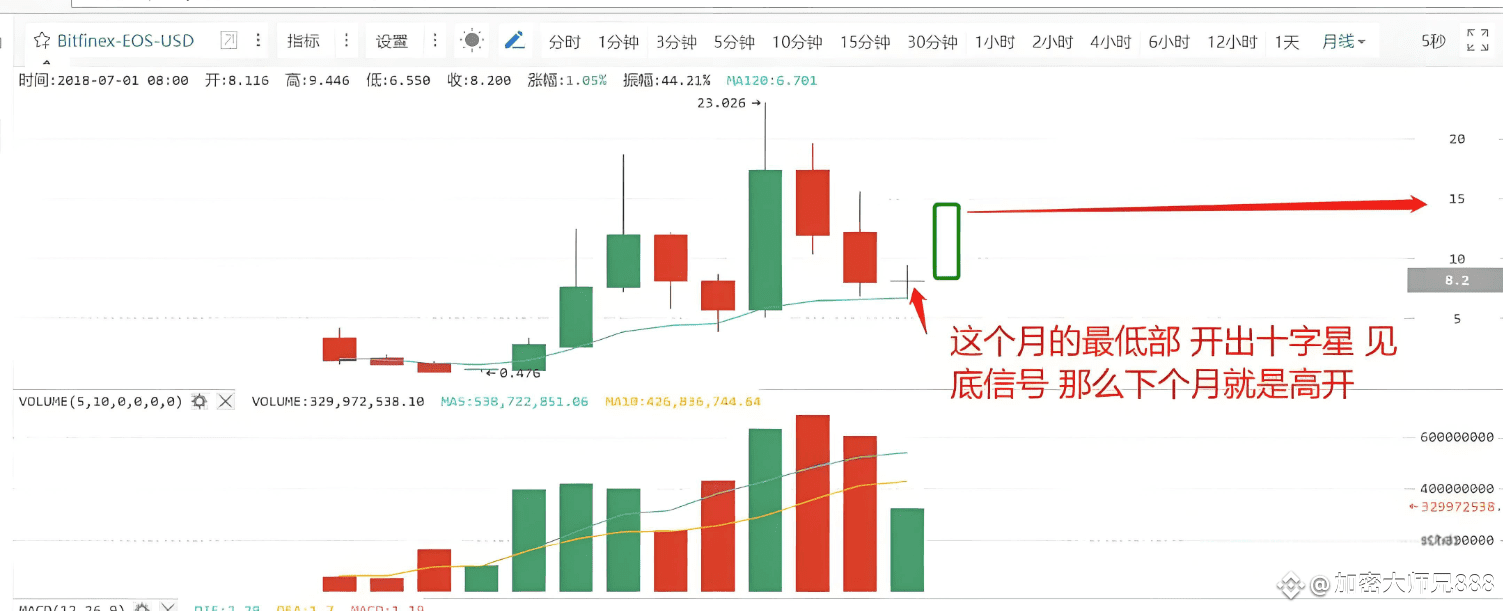
This is the previous technical chart, and according to the current market situation, it has not crossed the 120-day moving average. The use of the 120-day moving average is actually to determine long-term
Trend technical indicators are also a reference in daily trading. This bear market has not yet ended, and once it crosses the 120-day moving average,
The daily moving average is the indicator for determining the arrival of a bull market.
What we often see as pressure and support levels are actually moving averages. When analyzing major trends, long-term investors
You cannot rely solely on the 5-day moving average strategy; the primary moving average for reference when transitioning between bull and bear markets is the 120-day moving average.
5. Box wave analysis to observe pressure and support.
This is from Elliott Wave Theory*, which has a good explanation of wave trading strategy. Many novices in the stock market have relied on this theory to
After years of scanning the stock market, of course, whether it is practical or not remains to be seen, as seeing is believing. Here, we briefly introduce the support and
Resistance level.
When the price of a currency operates within a certain box, the waves formed each time have their highest points on a line, which is the resistance level. The lowest points of the waves
Connecting parts form a support level. The general judgment is that once broken, it may face a higher charge. In this case, how to select.
What to choose? The main point comes from the fundamentals, which is to follow the trend when positive news is released or when significant funds enter the market.
In one situation, it breaks out and consolidates, which is also quite common, indicating that funds are unable to push higher or there is too much selling pressure. At this time, it is necessary to
more cautious. Of course, the range can be quite large, so it can only serve as a reference.

Through box waves, observe each low and high point to judge support and resistance, which is also a relatively common analysis method—simple and straightforward.
However, it is not that accurate, and everyone can explore this in daily practice or look at wave theory technical books. Of course, it is said to be,
I have read several good wave theory books, and in practical combat, the effect is not very good, but that does not mean that everyone will not see results after reading it.
Everything still relies on practical exploration. I prefer practical techniques rather than conceptual things. What do you all think?
6. RSI bottom fishing and top escaping rule.
RSI is also an old technical indicator in the stock market, and it works particularly well as a reference in the cryptocurrency market.
The RSI indicator represents a degree of strength, calculated from the statistics of price increases and decreases.
The principle of the RSI indicator, simply put, is to calculate the strength comparison between buyers and sellers using numbers. For example, if a hundred people buy
If one currency is bought by sixty people and sold by forty, the price will rise.
So how to use it? 80 to 100 is extremely strong sell; 20 to 50 is extremely strong buy; weak watch 0 to 20 is extremely weak buy.
Once a golden cross is reached, it becomes a buy-sell point.
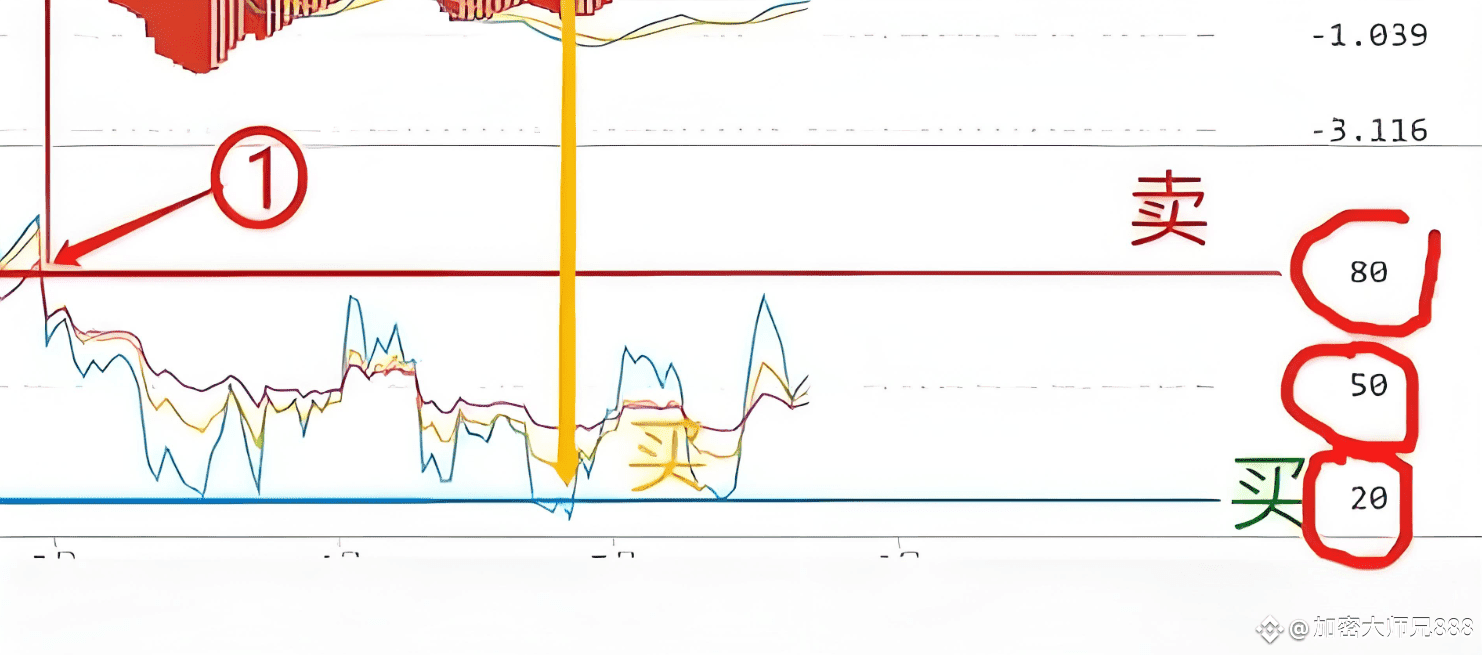
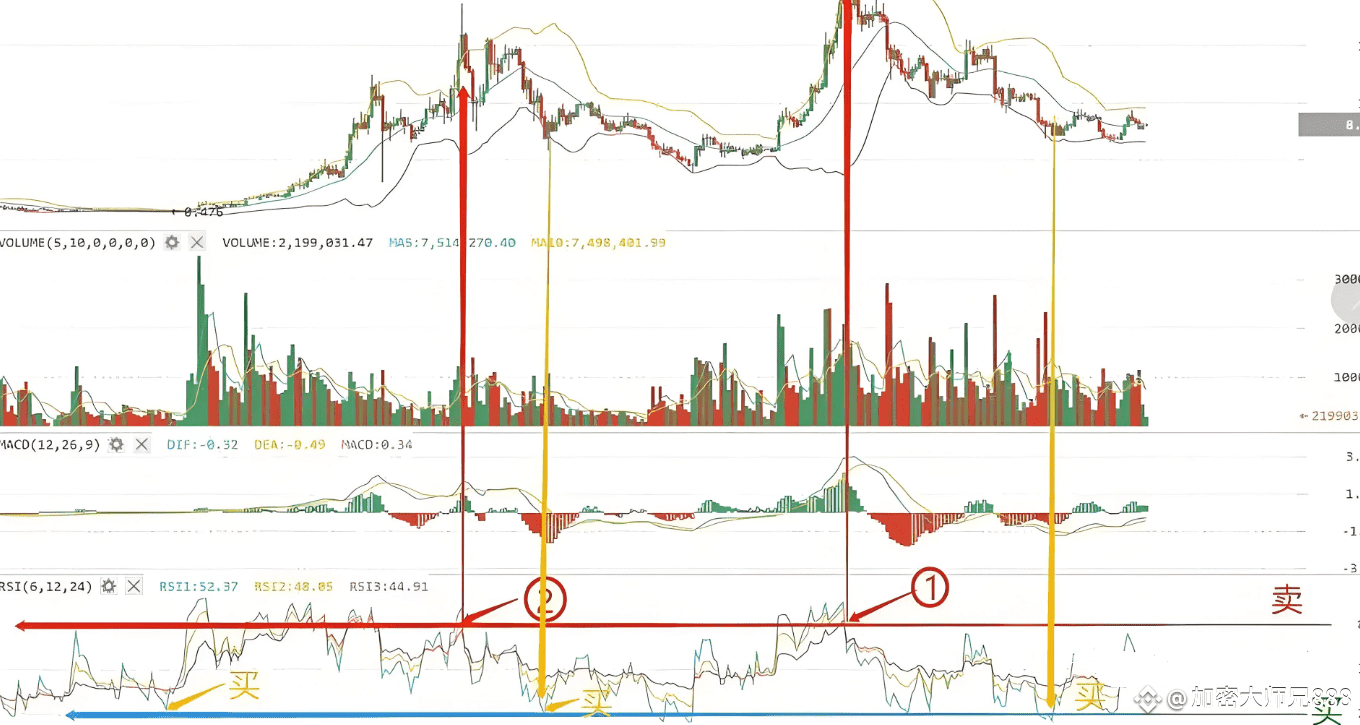
Note that if it reaches 80, there is a significant risk of a pullback. So when should you sell? Sell at the moment it breaks below 80. The RSI technique is
It has been market-validated; it has been used since its research in 1978, indicating its reference value. In the emerging currency market,
In the cryptocurrency market, this set of indicators can effectively lead you to victory.
Short-term bands can choose the one-hour chart for operation to achieve band top escape.
Summary: Let's review the five types of technical indicators we discussed today: 5-day moving average strategy, 10-day and 30-day moving average combination indicators, medium
The roles of the 60-day and 120-day moving average strategies, box wave support and resistance levels, and the RSI bottom fishing and top escaping rules. Although the reference indicators mentioned above,
Many indicators are quite simple, but in practice, the simpler reference indicators are often more effective. In practice, we have introduced five types of technical
There are various trading methods through practical investment. I believe that there is always something that can bring you a different investment experience, and something that can become your powerful tool on the investment path.
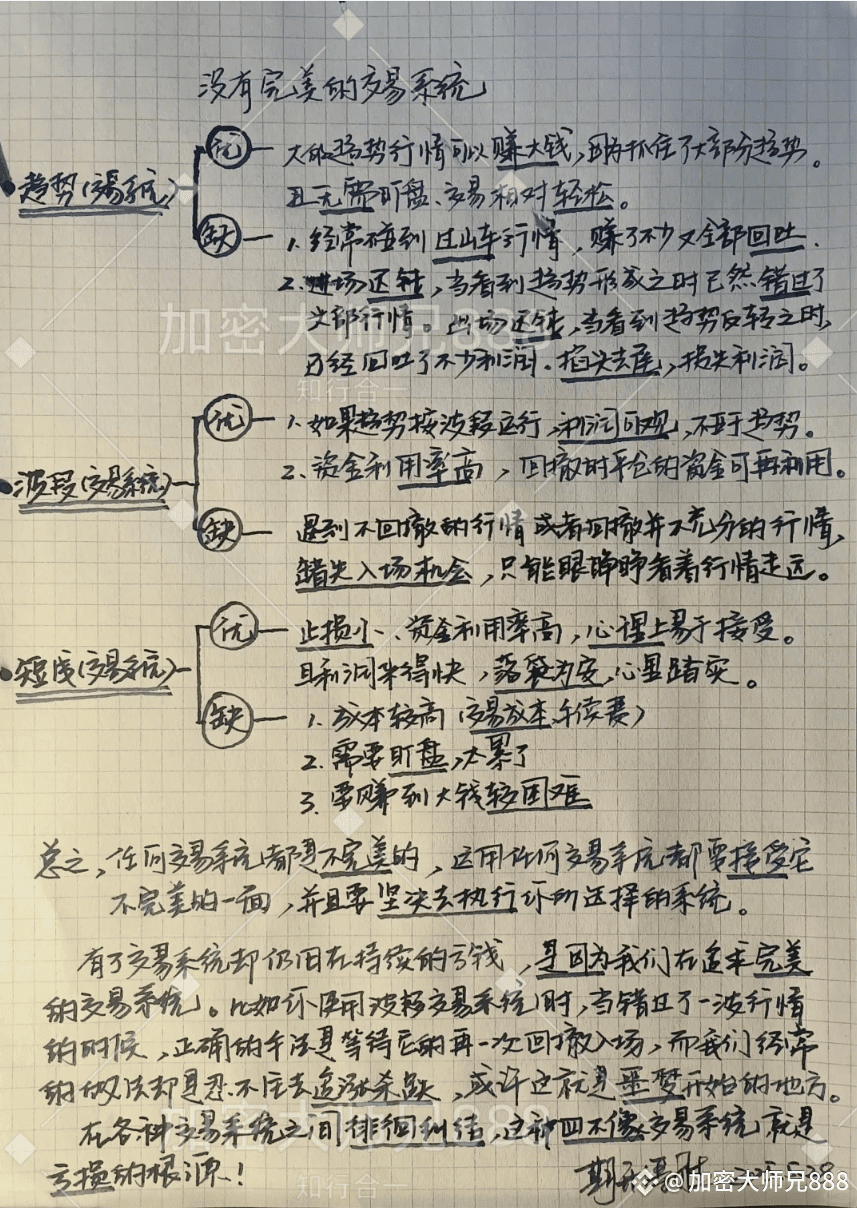
You don't have to stay up late watching the market and guessing trends, and you don't need to worry about whether buy and sell points are accurate. Only take opportunities where the trend is clear. In a bear market, hold back, and in a bull market, hold on to your positions. @加密大师兄888 In the next wave of the market, I will say that we will follow the rhythm and profit, letting our profits outperform 90% of retail investors! Remember, the cryptocurrency market does not lack opportunities; what it lacks is the execution power to keep up.